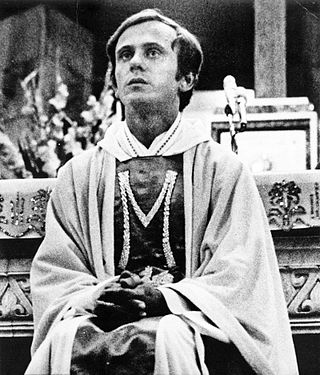
Jerzy Popiełuszko was a Polish Roman Catholic priest who became associated with the opposition Solidarity trade union in communist Poland. He was murdered in 1984 by three agents of Służba Bezpieczeństwa, who were shortly thereafter tried and convicted of the murder.
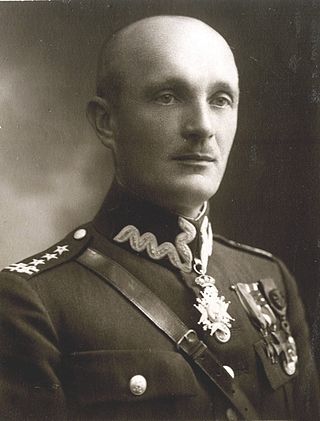
National Armed Forces was a Polish right-wing underground military organization of the National Democracy operating from 1942. During World War II, NSZ troops fought against Nazi Germany and communist partisans. There were also cases of fights with the Home Army.

Ostrów Mazowiecka(listen) is a town in eastern Poland with 23,486 inhabitants (2004). It is the capital of Ostrów Mazowiecka County in Masovian Voivodeship.

Zygmunt Szendzielarz was the commander of the Polish 5th Wilno Brigade of the Home Army, nom de guerre "Łupaszka". He fought against the Red Army after the end of the Second World War. Following the Soviet takeover of Poland at the end of World War II he was arrested, accused of numerous crimes and executed in the Mokotów Prison as one of the anti-communist cursed soldiers. After the fall of communism, in 1993, Szendzielarz was rehabilitated and declared innocent of all charges. In 2007 Polish president Lech Kaczyński posthumously awarded Szendzielarz with the order of Polonia Restituta. His involvement in the Dubingiai massacre of 1944, however, remains controversial.

The "cursed soldiers" or "indomitable soldiers" is a term applied to a variety of anti-Soviet imperialist and anti-communist Polish resistance movements formed in the later stages of World War II and its aftermath by members of the Polish Underground State. This all-encompassing term for a widely heterogeneous movement was introduced in the early 1990s.

The King Jagiełło Monument is an equestrian monument of Władysław II Jagiełło, King of Poland and Grand Duke of Lithuania, located in Central Park, New York City. The monument commemorates the Battle of Grunwald, a decisive defeat of the Teutonic Order in 1410. Originally made by Stanisław K. Ostrowski for the Polish 1939 New York World's Fair pavilion, the monument was permanently installed in Central Park in 1945. Raised on its grand plinth it is one of the most prominently sited and impressive of twenty-nine sculptures located in the park.
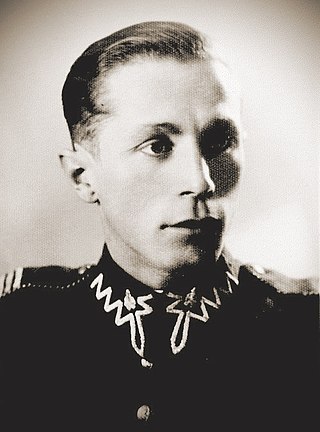
Józef Batory was a Polish soldier and resistance fighter during World War II and after.

The anti-communist resistance in Poland, also referred to as the Polish anti-communist insurrection fought between 1944 and 1953, was an anti-colonialist and anti-imperialist armed struggle by the Polish Underground against the Soviet colonization of Poland at the end of World War II in Europe. The guerrilla warfare conducted by the resistance movement formed during the war, included an array of military attacks launched against communist prisons, state security offices, detention facilities for political prisoners, and prison camps set up across the country by the Stalinist authorities.
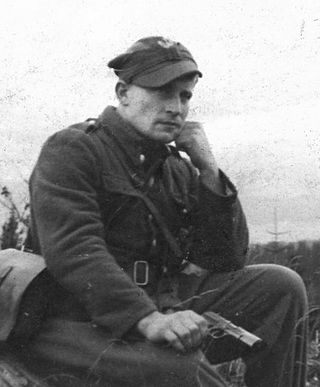
Józef Kuraś, noms-de-guerre "Orzeł" (Eagle) and from June 1943 "Ogień" (Fire), was born in Waksmund near Nowy Targ. He served as lieutenant in the Polish Army during the invasion of Poland, and became the underground member of Armia Krajowa and Bataliony Chłopskie in the Podhale region. After the end of World War II, he continued his fight against the Communist authorities and was one of the leaders of the so-called "cursed soldiers".

Andrzej Pitynski was a Polish-American monumental sculptor who lived and worked in the United States. A book of his works was published in 2008.

Danuta Helena Siedzikówna was a Polish medical orderly in the 4th Squadron of the 5th Wilno Brigade in Home Army. In 1946 she served with the Brigade's 1st Squadron in Poland's Pomerania region. Considered a national heroine, she was captured, tortured and sentenced to death at the age of 17 by the communist authorities.
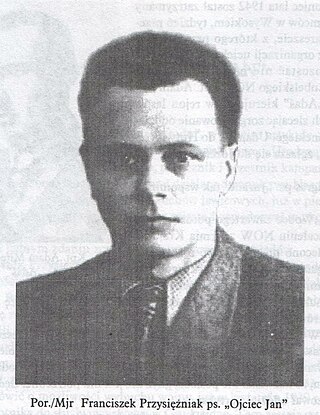
Franciszek Przysiężniak - was a lieutenant in the Polish Army, an officer of anti-communist resistance groups National Military Organization (NOW) and National Military Union (NZW).

Emilia Malessa, née Izdebska, was a Polish soldier, member of the Home Army with the rank of Captain, participant in the Warsaw Uprising, member of the underground anti-communist organization Freedom and Independence (WiN), and a "cavalier" of the Order of Virtuti Militari.

The Katyń Memorial is a bronze statue created by Polish-American sculptor Andrzej Pitynski in dedication to the victims of Stalin's March 5 1940 Katyn massacre in which thousands of Polish Army officers and intellectual leaders who had been interned at Kozielsk or imprisoned at Ostashkov and Starobielsk had been killed by the occupying Soviet People's Commissariat for Internal Affairs, or NKVD. The memorial stands at Exchange Place in Jersey City, New Jersey, United States, near the mouth of the Hudson River. Unveiled in June 1991, the statue depicts a bound and gagged Polish soldier with a bayoneted rifle impaled through his back. The statue stands 34-foot-tall (10-meter) and is atop a granite base containing Katyn soil. Its base also depicts a Polish woman carrying her starving child in memorial to the Polish citizens deported to Siberia that began shortly before the massacre.

America's Response Monument, subtitled De Oppresso Liber, is a life-and-a-half scale bronze statue in Liberty Park overlooking the National September 11 Memorial & Museum in New York City. Unofficially known as the Horse Soldier Statue, it is the first publicly accessible monument dedicated to the United States Special Forces. It was also the first monument near Ground Zero to recognize heroes of the September 11 terrorist attacks.

The National Katyń Memorial is a monument in Baltimore, Maryland, which memorializes the victims of the 1940 Katyn massacre of Polish nationals carried out by Soviet forces. Baltimore's Polish-American community was instrumental in having the monument built. The monument was unveiled in 2000 and is the tallest statue in Baltimore. The statue itself is 44 feet high, the whole monument, with base, is 56 feet.

Freedom Monument is a monument in Bydgoszcz commemorating both the fallen Soviet and Polish soldiers who fought during the liberation of the city in January 1945, and the return of Bydgoszcz to Poland on 20 January 1920.

The Prince Józef Poniatowski Monument in Warsaw is a monument currently located at 46/48 Krakowskie Przedmieście in the courtyard of the Presidential Palace. Created by Rome-based Danish sculptor Bertel Thorvaldsen in 1829, it depicts Józef Poniatowski (1763–1813) riding and horse and dressed as Roman general.

The 1946 pacification of villages by PAS NZW was the killing of 79 Polish nationals of Belarusian ethnicity in Bielsk County, north-eastern Poland, by partisans, members of the Polish Extraordinary Special Actions unit of the National Military Union. The murders took place in the aftermath of World War II.
Piotr Triebler (1898–1952), was a Polish sculptor whose works are associated with Kuyavian-Pomeranian Voivodeship in general and with Bydgoszcz in particular.



















